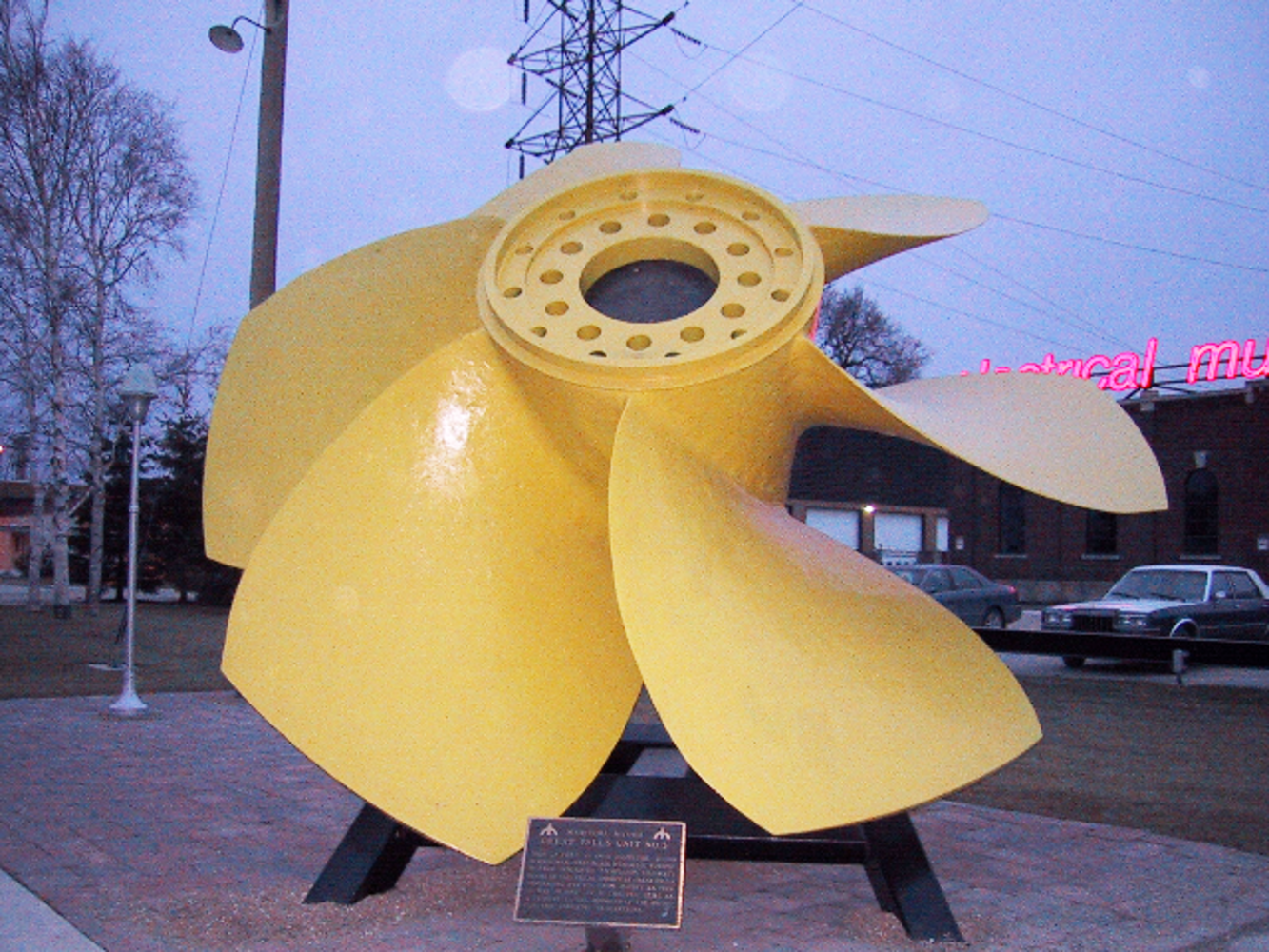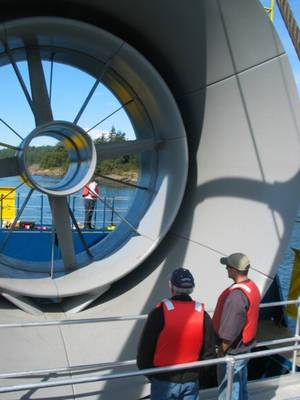Naked Engineering - Green Tide Turbines
Interview with
Small scale turbines that can harness energy locally from winds, tides, and rivers can be a very valuable asset in bringing power to remote populations which makes the technology that a company called 'Green Tide Turbines' are working on potentially very valuable. Meera and Dave went to meet Green Tide Turbines' CEO, Michael Evans and his colleagues to find out a bit more.
 Michael - Well, if we're talking about a tidal turbine, we're developing technologies that have to survive some of the most aggressive environments in the whole planet. We've got heavy moving water which contains huge amounts of energy, often in very remote locations which are very hard to access because obviously, you've got these very strong tidal currents, and also, some extremely large forces, which is the whole reason why we want to put turbines there, to tap some of that. So, the emphasis really needs to be on devices that are really, really simple, very easy to maintain, very robust, and also, quite cheap.
Michael - Well, if we're talking about a tidal turbine, we're developing technologies that have to survive some of the most aggressive environments in the whole planet. We've got heavy moving water which contains huge amounts of energy, often in very remote locations which are very hard to access because obviously, you've got these very strong tidal currents, and also, some extremely large forces, which is the whole reason why we want to put turbines there, to tap some of that. So, the emphasis really needs to be on devices that are really, really simple, very easy to maintain, very robust, and also, quite cheap.
Dave - I guess the different thing to do would be to take the main technology like take a wind turbine and stuff it underwater.
Michael - Absolutely. A lot of our competitors have followed that very philosophy. Basically, they've just got wind turbines with shorter blades that are made to be waterproof, and they dump them under the sea. The sea just isn't water. There's lots of stuff that it carries in it. Things like fishing nets, even submerged containers that have been washed off ships for instance. These all find their way into these fast moving flows of water and they're basically flung at these devices. So you've got these wind turbines with their delicate blades spinning around in a flow regime and when these things get hit by these objects, they're not going to survive particularly well.
Meera - To tell us more about how the Green Tide Turbine design approaches these challenges is Tom Clark who is the Research Director...
Tom - Well we have a different kind of concept which is moving away from the "wind turbines underneath the sea". What we do is we put much smaller rotors inside a duct which allows us to capture a similar amount of energy, but using a much smaller and more robust rotor.
Dave - I guess the first thing I'd say if you've got a very small rotor and you're squirting lots of water past it, surely if it is moving very fast, this turbine should be spinning very quickly and kind of mash anything which it hits.
Tom - That's right. But what we've been able to do, Dave, is use both the stator and a rotor. So, a stator is essentially like a rotating turbine but fixed in position. What that does is it causes a swirl of fluid inside the duct and then the rotor takes out that swirl and generates energy by doing so. So, although the rotor is moving fairly fast, it's not moving as quickly as perhaps a design without a stator.
Meera - So you're regulating the flow of water approaching the rotor?
Tom - That's right. That has the additional benefit actually that any turbulence and gustiness in the incoming stream is actually straightened and aligned as well. A lot of people don't realise it, but the tides don't move just uniformly. There's a lot of turbulence, swirling eddies, and so on, and currents which upset the behaviour of turbines in the current. The benefit of our design really is that you can actually stack our turbines closer together in a tidal farm than with open tide turbine designs.
 Dave - So your system's causing the water to spin and then you're changing the direction of that spinning water completely using your rotor, so because you changed direction a lot, you don't need to be moving the rotor as quickly.
Dave - So your system's causing the water to spin and then you're changing the direction of that spinning water completely using your rotor, so because you changed direction a lot, you don't need to be moving the rotor as quickly.
Tom - That's right, yes because we have a swirling motion in the inside of our duct, our rotor can be moving much more slowly. Effectively, it moves with the water. So there's less of a relative speed between the water and the rotor. So, it's much less damaging for fish and it's much less likely to get debris and other objects caught in the flow through the turbine.
Meera - You mentioned that they can be situated quite close to each other, but what's the actual dimensions of the turbines?
Tom - Our tidal turbines in general are in the range of 10 to 15 metres in outside diameter. But the ducts are quite big so the rotors are actually substantially smaller than that, of the order 6 metres.
Meera - We're at one of your test sites now which is alongside a river and you've got a tunnel through which water is flowing through. It's about 1.5 to 2 metres wide, and you've got one of your turbines placed in the middle. It's about 1 foot wide in diameter. Tell me a bit more about how this setup works.
Tom - Well it's called a Venturi arrangement. Essentially, there's a nozzle which accelerates flow into our turbine for the purposes of testing because we need a higher flow rate to accurately test the turbine. So, the flow rates that we reach in the test section of our water tunnel are around about 2 metres per second. The action of the duct around the turbine actually accelerates fluid through the turbine disc which means that the velocity inside the duct is slightly higher than the mean flow rate. It's about 2 ½ or 3 metres per second. We have a part of the flow of a river diverted through our test facility. We can control the facility, we can control the flow rate of the river using a sluice gate up in front of our turbine.
Meera - Can we see it in action then?
Tom - You certainly can. All we need to do is open up the sluice gate.
Meera - Right. So the sluice gates are open and the water is now just flooding through!
Tom - That's right. Flowing through the tunnel is about 3 cubic metres per second of water. We've got water travelling up to 2 metres per second.
Meera - Going through then the turbine, how much power will be generated here?
Tom - That corresponds to a power of about 500 watts. It really isn't very much. That's about half a household kettle, but I should say that it's a very, very small model that we're using. The energy capture scales up dramatically as you increase the diameter up to a tidal turbine scale. Our commercial scale turbines typically produce around 1 megawatt of power which is useful, I think that generates enough power for about 300 homes.
Meera - Having seen this in action then, now moving back to you Michael, where is it hoped these turbines will be used? What are the upcoming projects?
Michael - Well we've had a great deal of interest from developing countries where there's lots of rural communities well away from established infrastructure needing power and relatively small amounts of power. Generating power for lighting, for running mobile communication systems, and things like that. One country in particular who were very keen on our technology is Brazil. So this will be on a scale of about 1 metre in diameter installed in probably Northern Amazon region initially. That'll be generating around about 5 kilowatts of energy.
Dave - If you're going to put diesel generators up there, you still have to ship the diesel up there regularly. So, this is even less hassle than that.
Michael - Absolutely and on top of that, you know, you've got a lot of enthusiasm for clean technologies, and other alternatives such as photovoltaics and wind wouldn't really work in a rainforest type of environment, where obviously you've got lots of clouds most of the day. And also, with the trees, there's not very much wind at usable level. So, the river generation technology is ideal for this sort of environment.
Dave - So although you started off building a tidal turbine, you ended up putting it in rivers instead.
Michael - Making smaller turbines is a lot cheaper obviously and we need to prove our technology. The river turbine is a fantastic test bed to actually develop the technology.










Comments
Add a comment